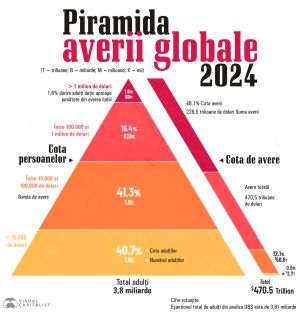Today, the BURSA newspaper is organizing the third conference with the topic "The Role of banks in the restructuring of companies". The agenda of the conference is comprehensive and it is trying to answer some questions of major current interest, such as the ones concerning the regaining of trust by the banking system, the ways of increasing the loans extended to companies or of the role of banks in attracting European grants.
But what if it is too late to restructure the huge volume of non-performing loans in the banking system, and banks can only help SMEs by turning down their loan applications?
Why? Because the restructuring can begin before the granting of the loan. That statement may seem absurd, but only at first glance.
How many times were entrepreneurs or even major companies encouraged to take out greater loans than they initially intended, by banks who were very "lax" with the appraisal of the collateral, and only taking a very cursory glance at the competitive environment and the sector outlook? To say nothing of the "solutions" offered to individuals, who did not have the required downpayment for a mortgage loan?
Amid the exuberance and the rush for market share in the period which preceded the crisis, the banks did not fulfill their role of partner of the business sector, which should have also included warning the client about overleveraging or about applying for a loan that far exceeded their repayment ability.
The officials of the NBR repeatedly said that bank's credit analysts should know how to read a balance sheet. But it that enough? No, because the balance sheet reflects a past situation and does not guarantee that a company will be able to overcome the obstacles it may face in the future, especially if the time frame is greater than a few years, and the world's and regional economy is shaken by an unprecedented crisis.
It is precisely the effects of this crisis that were not evaluated adequately by commercial banks. And as for the "vision" of the National Bank of Romania what else would be left to say? It could have been great, perhaps, had there been any.
Concerning the latest data from the banking system, it could be said that the failure of the monetary and oversight policies in the banking system is complete.
According to data from the NBR concerning loans and deposits across the country, the rate of overdue loans was 15.1%, as the amount of the receivables has remained unchanged, to 33.62 billion lei, but the credit balance of decreased 2.5 billion lei.
In October 2010, the rate of arrears was 7.6%, and the total balance of the loan granted to non-government customers was 208.3 billion. Since then, the value of the overdue loans (author's note: just the principal and the off-balance sheet positions, according to the stipulations of the NBR) has increased 111.4%, while the total balance has increased 6.9%.
How much should non-governmental borrowing increase to return to the rate of overdue loans to return to the rate of arrears from October 2010, when the value of the arrears is the one of October 2013? Almost twice, to about 440 billion lei!
For an annual credit increase of 5%, it would take over 14 years to return to a rate of arrears similar to the one of October 2010 or 7 years, if the yearly growth of lending were 10%.
It is obvious that such a scenario has no chance of occurring whatsoever, so the banking system needs a massive recapitalization, which would offset the losses of the non-performing loans. But this scenario seems unlikely too, because it is hard to believe that the major foreign banks present on our market would acknowledge their mistakes that easily, when our own authorities are ready to accept loans of tens of billions of Euros from the international institutions for "macrostabilization".
Many years after the beginning of the global financial crisis, the NBR is forcing the resumption of lending by lowering the policy rate, even though the examples of the developed economies show that the effort is pointless, even with interest rates close to zero.
It is enough to look at the correlation between the evolution of the loans granted and the commitments made by the lenders and the interest rates over the last few years (see chart 1).
Up until near the end of 2009, the balance of loans increased very quickly, in spite of the increase of the interest rate, and the balance peaked in the second half of 2012, amid the drop in the borrowing costs.
The correlation between non-governmental loans and the policy rate is even stranger (see chart 2).
Since 2012 the two variables have begun shrinking in unison, even though in theory, a drop of the monetary policy rate should have provided the necessary conditions for an increase in non-governmental borrowing.
So how does the NBR hope to force the banks to set off on a new "subprime" adventure, especially amid the drastic drop in the quality collateral required for the guarantee of the loans? Are they really not aware of the effects of overleveraging, among companies as well as among the households?
The estimates published in the press, after the publication of the report of the NBR concerning financial stability, show that the Romanians are among the most heavily indebted Europeans, in proportion to their income. And revenues don't show any signs of increasing soon, with the exception of election-motivated "adjustments" in the public sector. There is no way for them to grow anyway, because the conditions for higher productivity, including an environment supportive of the development of domestic capital, does not exist.
The fiscal policy of the government shows that we have still a long way to go from the current policy of punishing work and capital to their stimulation. In fact, the authorities don't even realize that work and capital don't need to be stimulated, they just need the current insurmountable obstacles to be removed from their path.
In this context, it is obvious that the rhetoric of the NBR is only intended to cover the true purpose of the cut of the policy rate: reducing the government's borrowing costs, while keeping a minimum appearance of independence.
Unfortunately, time flows inexorably against the government, which is ready to do anything but release the entrepreneurial spirit from the yoke of the state.
A document by the Eurostat shows the main differences between the European System of National Accounts ESA 95 and its revised version, ESA 2010. An important item in it is "the clarification of the transactions between the government and public companies to improve the elements which can significantly affect the government debt". Thus, ESA 2010, which will come into effect in September 2014, is trying to close a series of loopholes for hiding the true level of the public debt.
The effect it will have on Romania is not hard to imagine, considering the countless warnings from the IMF about the level of arrears: the increase of public debt, both in absolute terms and in relation to the GDP. The only surprise will be the scale of the spike.
Then, international lenders will ask us for new austerity measures and new tax hikes, meaning a new revision of the taxation rate, which is already marked by an extraordinary "volatility".
Let's assume that the banks will clean up their balance sheets (author's note: the fantasy version is that of a cleanup that doesn't involve costs for the state budget), abusive lending terms will become only a memory, and banks and the National Bank will regain the trust of the population (yes, I've been reading too much science-fiction).
What will happen? Nothing, because no matter how many agreements we sign with China, growth can only come from the accumulation of domestic capital. Which means we need higher interest rates, which would encourage saving and discourage consumer credit.
Without all that, the restructuring of bank loans is nothing but empty talk, without any consequences for the return of optimism, or the relaunch of the economy.
"The journey of a thousand li (author's note: Chinese distance unit equivalent to 500 meters) begins with the first step", Chinese philosopher Lao Tzu once said. When will we take that first step?



























































